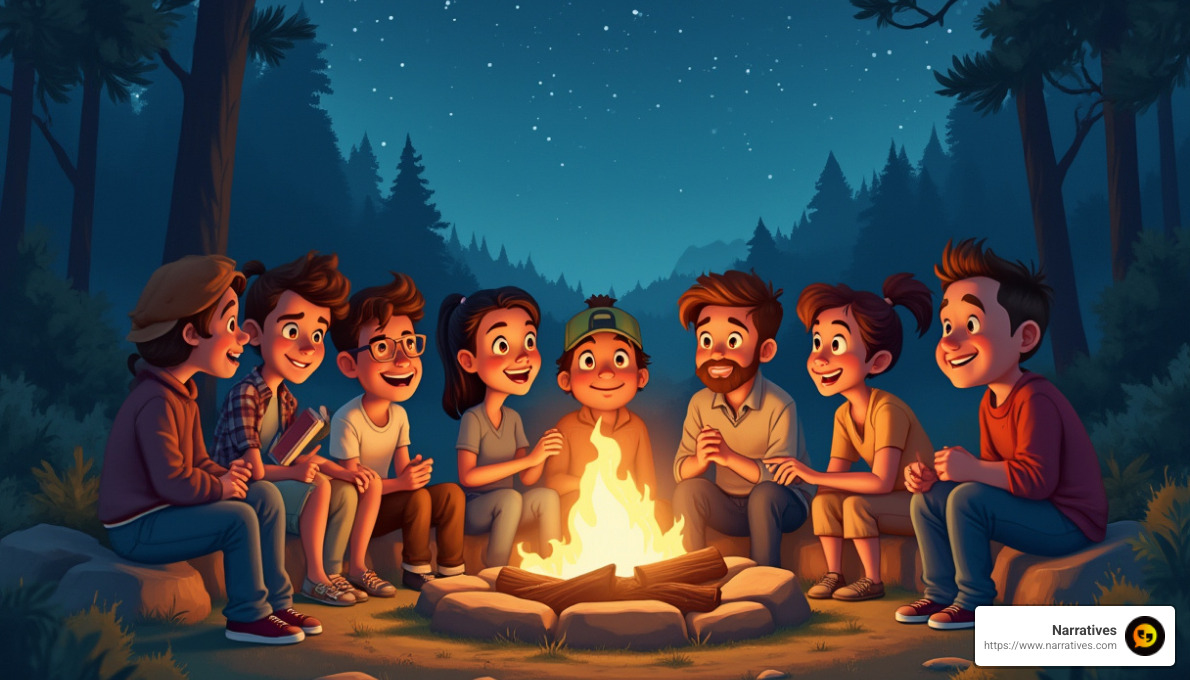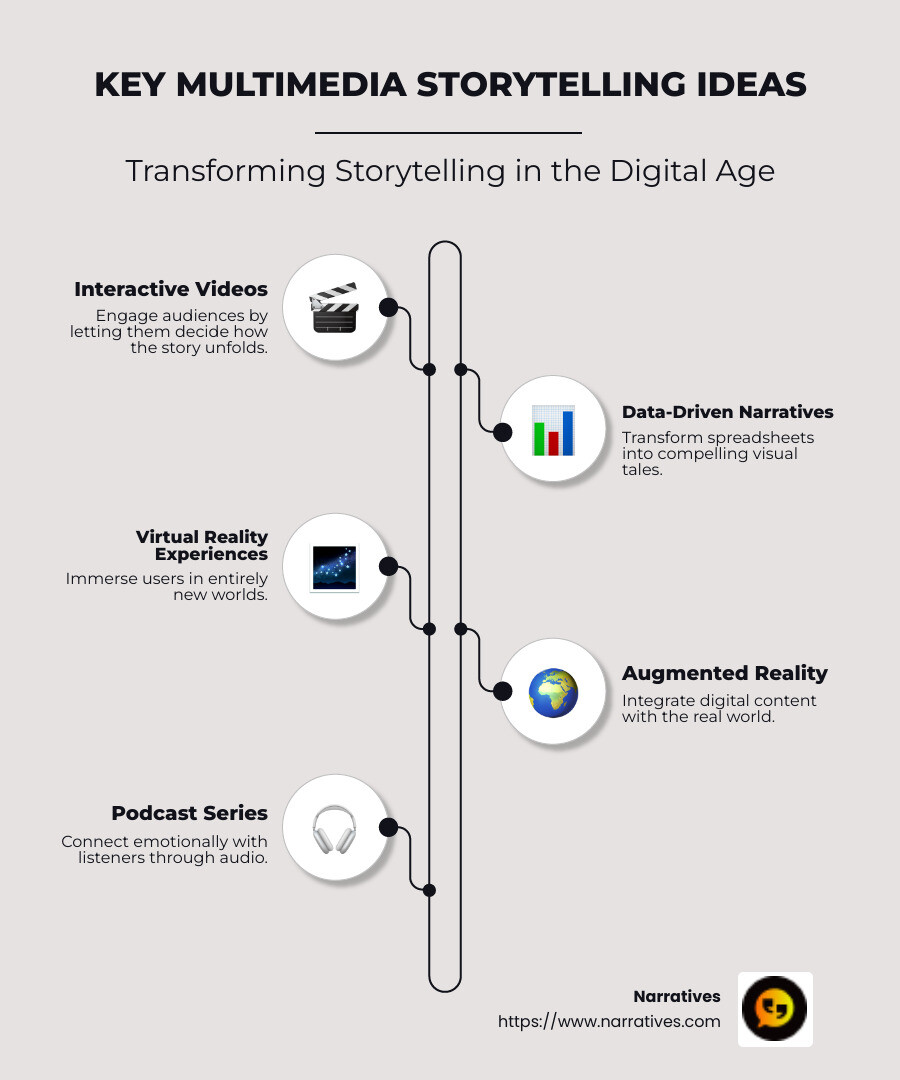Storytelling Unleashed: Top Multimedia Ideas for Creators

Multimedia storytelling ideas are changing how we share and experience stories today. Whether you're a non-profit seeking to lift your mission or a brand focusing on advocacy, the digital age offers incredible opportunities for creative expression. Here's a quick list of multimedia storytelling concepts to get you started:
- Interactive Videos: Engage audiences by letting them decide how the story unfolds.
- Data-Driven Narratives: Transform spreadsheets into compelling visual tales.
- Virtual Reality Experiences: Immerse users in entirely new worlds.
- Augmented Reality: Integrate digital content with the real world.
- Podcast Series: Tap into the power of audio to connect emotionally with listeners.
In the 21st century, storytelling is not just about telling; it's about creating an experience. Digital storytelling combines elements like text, images, video, and audio to craft stories that engage both the heart and mind. As Jason Ohler suggests, this medium turns passive tech consumers into active creative participants.
Today's digital tools make it possible for anyone with a smartphone or computer to become a storyteller. With little cost involved, you can produce and publish engaging narratives that resonate with wide-ranging audiences. For organizations focused on social impact and advocacy, leveraging these tools is key to amplifying their mission.
Get ready to explore how you can use these ideas to share your story with the world. Let's explore the art of multimedia storytelling in the sections that follow.

Understanding Multimedia Storytelling
Digital storytelling is revolutionizing how we communicate. It blends text, images, video, and audio to create stories that captivate both the heart and the mind. This approach transforms traditional storytelling into an immersive experience that can be both entertaining and educational.
One of the most exciting aspects of digital storytelling is interactive content. This type of content invites the audience to engage actively with the story. Think of it as a conversation rather than a one-way broadcast. Interactive elements can include clickable graphics, scroll-triggered animations, and quizzes. These features not only keep the audience engaged but also make the storytelling experience memorable.
Types of Multimedia Elements
Digital storytelling employs various multimedia types to enrich the narrative:
- Text: The backbone of any story. It provides context and detail.
- Images: Photographs and illustrations break up text and add visual interest. They can evoke emotions quickly and effectively.
- Video: Offers dynamic storytelling possibilities. Techniques like scrollytelling use video clips and animations to create a cinematic reading experience.
- Audio: Adds depth to stories. Sound effects and spoken narration can set the mood and improve the emotional impact.
- Data Visualizations: Transform complex data into easy-to-understand visuals. Infographics, for example, can make statistics more engaging and digestible.

The beauty of multimedia storytelling lies in its versatility. For instance, the New York Times’ "Snow Fall" is a classic example. It uses video clips, photography, and animations to create an immersive reading experience that captures the audience's attention.
Multimedia storytelling ideas are not just for big media companies. With the right tools and a bit of creativity, anyone can create compelling digital stories. Platforms now offer no-code solutions, making it easier than ever for creators to focus on storytelling rather than technical details.
The potential for multimedia storytelling continues to grow. Whether you are a seasoned journalist or a non-profit organization, embracing these digital tools can amplify your message and engage your audience in meaningful ways.
Let's dive deeper into specific multimedia storytelling ideas in the following sections.
Top Multimedia Storytelling Ideas
Data-Driven Stories
Data visualizations and infographics are game-changers in storytelling. They turn complex data into visuals that are not only engaging but also easy to understand. Imagine changing a dull spreadsheet into a vibrant chart or an interactive infographic. This approach doesn't just inform; it captivates.
Consider using interactive maps to add layers to your story. These maps let users explore data geographically, providing context and depth. They invite readers to dive deeper, making the experience both educational and interactive.
Video Storytelling
Video clips are powerful tools in the multimedia arsenal. They bring stories to life in ways text alone cannot. Techniques like scrollytelling combine video with scrolling actions, creating a dynamic, cinematic experience.
Video production doesn't have to be complex. Short clips can be woven into narratives to maintain energy and engagement. Whether it's a quick interview or a scenic shot, video adds a layer of realism to storytelling.
Social Media Storytelling
Social media posts are more than just updates; they are opportunities to tell stories. Through hashtag campaigns, you can create a unified narrative that encourages user participation. This kind of user engagement transforms passive readers into active participants.
Think about leveraging platforms like Instagram or TikTok to share bite-sized stories. These platforms are perfect for reaching wide audiences with minimal effort.
Virtual and Augmented Reality
Virtual reality (VR) and augmented reality (AR) are at the frontier of immersive storytelling. They offer experiences that traditional media cannot match. With VR, you can transport your audience to entirely new environments, making them part of the story.
AR, on the other hand, overlays digital elements in the real world, offering interactive experiences that are both engaging and informative. These immersive environments are perfect for creating unforgettable storytelling experiences.
Podcasts and Audio Stories
Audio storytelling taps into the power of the spoken word. Podcasts are a popular medium for sharing stories in an intimate format. They allow for deep dives into topics with the added benefit of spoken narration and sound effects.
The beauty of audio is its ability to evoke emotions and create vivid mental images. It’s a versatile medium that can be used for everything from personal narratives to in-depth interviews.
By exploring these multimedia storytelling ideas, creators can craft stories that resonate with audiences. Whether you're using data visualizations, video, social media, VR, or audio, the goal is the same: to engage, inform, and inspire.
Multimedia Storytelling Ideas for Non-Profits
Non-profit organizations have a unique opportunity to leverage multimedia storytelling to amplify their social impact. By using creative storytelling techniques, they can connect with communities and drive their purpose-driven missions forward.
Social Impact Through Storytelling
Non-profits thrive on making a difference, and storytelling is a powerful way to showcase their impact. By sharing real-life stories of change, they can highlight the tangible results of their efforts. For example, a non-profit focused on education might use video storytelling to document a student's journey from struggling to succeeding, illustrating the power of their programs.
Community-Driven Narratives
Engaging the community is essential for non-profits. Interactive maps can be a great tool here. Imagine a map that shows all the areas a non-profit has helped, with clickable pins that reveal personal stories or testimonials from those communities. This approach not only informs but also involves the community in the storytelling process, making them feel like a part of the journey.
Purpose-Driven Organizations and Immersive Content
For organizations with a clear mission, immersive content like virtual reality (VR) can transport supporters into the heart of their cause. A VR experience could take donors on a virtual tour of a new school being built or let them experience the daily challenges faced by those the non-profit aims to help. This kind of immersive storytelling creates a strong emotional connection, encouraging deeper engagement and support.
Audio Stories and Podcasts
Podcasts offer a unique platform for non-profits to share their message. By featuring interviews with beneficiaries, volunteers, and experts, they can provide in-depth insights into their work. Audio storytelling allows listeners to engage with the content on a personal level, fostering empathy and understanding.
Leveraging Social Media for Engagement
Social media storytelling is a dynamic way for non-profits to reach wider audiences. By creating hashtag campaigns around specific initiatives, they can encourage user-generated content and amplify their message. This not only raises awareness but also builds a community of supporters who feel invested in the cause.
By incorporating these multimedia storytelling ideas, non-profits can effectively communicate their mission and engage with their audience in meaningful ways. Whether through video, audio, or interactive content, the goal is to inspire action and foster a sense of community around their cause.
Frequently Asked Questions about Multimedia Storytelling Ideas
What are some examples of multimedia storytelling?
Multimedia storytelling can take many forms, blending various media to create engaging narratives. Here are a few examples:
Digital Stories: These are narratives that combine text, images, and audio to create compelling stories. They often include personal anecdotes or testimonials to make the content relatable and impactful.
Interactive Maps: These maps allow users to explore stories by clicking on different locations. For instance, a non-profit can use an interactive map to show the regions they serve, with each click revealing a story or testimonial from that area.
Animations: Animations can bring complex ideas to life in a simple and engaging way. They are particularly effective in explaining processes or illustrating changes over time.
How can multimedia storytelling benefit non-profits?
Non-profits can leverage multimedia storytelling to create an emotional connection with their audience, which is crucial for building brand loyalty and engaging supporters. Here's how:
Emotional Connection: By sharing authentic stories through video or audio, non-profits can evoke emotions that resonate with their audience, making them more likely to support the cause.
Brand Loyalty: Consistent storytelling that highlights the organization's mission and values can foster trust and loyalty among supporters.
Audience Engagement: Interactive content, like quizzes or polls, encourages active participation from the audience, making them feel like part of the organization's journey.
What tools are needed for multimedia storytelling?
Creating effective multimedia stories requires a combination of tools and resources. Here are some essentials:
Editing Software: Tools like Adobe Premiere Pro for video editing or Audacity for audio editing are crucial for crafting polished stories.
Multimedia Assets: High-quality images, videos, and audio clips are the building blocks of multimedia content. Access to a library of stock media or the ability to create custom assets is valuable.
Digital Platforms: Platforms like Shorthand or Vev allow creators to build interactive and immersive stories without needing advanced coding skills.
By utilizing these tools and approaches, creators can develop impactful multimedia storytelling ideas that captivate and inspire their audiences.
Conclusion
Narratives stands as a guide for non-profits and purpose-driven organizations. We are committed to elevating underrepresented voices through impactful multimedia storytelling. Our approach is simple yet profound: to create high-quality, emotionally resonant content that inspires action and fosters deeper connections.
Storytelling has always been a powerful tool for change. With the rise of digital media, it has become even more accessible and effective. By partnering with us, non-profits can harness the full potential of multimedia storytelling to share their impact stories. This not only builds trust and increases visibility but also strengthens the bond with their community.
Why Choose Narratives?
Expertise in Social Impact: Our focus is on creating content that highlights social impact, making us the ideal partner for non-profits aiming to make a difference.
Community-Driven Storytelling: We believe in the power of community. Our stories are crafted to reflect the voices and experiences of those who are often unheard, ensuring authenticity and emotional depth.
Innovative Multimedia Solutions: From engaging videos to interactive maps, we offer a wide range of multimedia solutions custom to meet the unique needs of non-profits.
By choosing Narratives, you're not just telling a story; you're creating a movement. Our goal is to help you share your mission in a way that resonates and inspires.
Ready to release your storytelling potential? Learn more about how we can help your organization make an impact.


